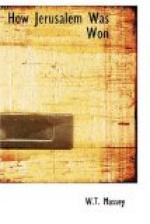’Up none of the other valleys of the Shephelah has history surged as up and down Ajalon and past Gezer, for none are so open to the north, nor present so easy a passage to Jerusalem.’
CHAPTER XII
LOOKING TOWARDS JERUSALEM
The Anzac Mounted Division had only the 1st Australian Light Horse and the New Zealand Mounted Rifles Brigade operating with it on the 14th. The Australians, by the evening, were in the thick olive groves on the south of Ramleh, and on the ridges about Surafend. On their left the Turks were violently opposing the New Zealanders who were working along the sand-dunes with the port and town of Jaffa as their ultimate objective. There was one very fierce struggle in the course of the day. A force attacked a New Zealand regiment in great strength and for the moment secured the advantage, but the regiment got to grips with the enemy with hand-grenades and bayonets, and so completely repulsed them that they fled in hopeless disorder leaving many dead and wounded behind them. It was unfortunate that there was no mobile reserve available for pursuit, as the Turks were in such a plight that a large number would have been rounded up. General Cox’s brigade seized Ramleh on the morning of the 15th, taking ninety prisoners, and then advanced and captured Ludd, being careful that no harm should come to the building which holds the grave of St. George. In Ludd 360 prisoners were taken, and the brigade carried out a good deal of demolition work on the railway running north. The New Zealanders made Jaffa by noon on the 16th, the Turks evacuating the town during the morning without making any attempt to destroy it, though there was one gross piece of vandalism in a Christian cemetery where monuments and tombstones had been thrown down and broken. In the meantime, in order to protect the rear of the infantry, five battalions of the 52nd Division with three batteries were stationed at Yebnah, Mughar, and Akir until they could be relieved by units of the 54th Division advancing from Gaza. To enable the 54th to move, the transport lent to the 52nd and 75th Divisions had to be returned, which did not make the supply of those divisions any easier. The main line of railway was still a long way in the rear, and the landing of stores by the Navy at the mouth of the wadi Sukereir had not yet begun. A little later, and before Jaffa had been made secure enough for the use of ships, many thousands of tons of supplies and ammunition were put ashore at the wadi’s mouth, and at a time when heavy rains damaged the newly constructed railway tracks the Sukereir base of supply was an inestimable boon. Yet there were times when the infantry had a bare day’s supply with them, though they had their iron rations to fall back upon. It speaks well for the supply branch that in the long forward move of XXIst Corps the infantry were never once put on short rations.




